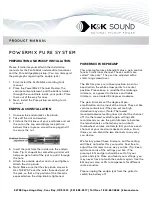
12 / 23
FLUSH TIMES/INTERVAL
s
st
t
M E
INTERNAL FLUSH TIME
00s
Interval pause
1m
External flush time
00s
LIMIT VALUES
s
st
t
M E
Limit val. Cl: 0.50 mg/l
LIMIT VAL. TH: 0.30°dH
HYSTERESIS LV1
s
st
t
M E
Analysis (1,2,3)
1
Setting the timer
Internal flush
In order to ensure the analysed sample represents the current value, the sampling
tube must be sufficiently well flushed taking its length into consideration. After the
installation has been out of operation for a longer period, or in the case of long
analysis intervals, it is sensible to select a flushing time in excess of 60 seconds. Flush is initiated by simultaneously
opening the inlet and the outlet valve of the Testomat
®
2000 THCl.
L
The analysis interval directly depends on the programmed flush time. If a flush time of, for example, 60 seconds is
set, the analysis interval itself cannot be shorter than 60 seconds.
External flush
An external flush valve should be installed upstream of the Testomat
®
2000 THCl if very short analysis intervals are
required, the sampling tube is very long (several metres), or when using a tube with a large diameter. This is connected
to the "Flush" outlet. The external flush time for the valve depends, like the flush time for flush by the unit, on length and
diameter of the connection to the Testomat
®
2000 THCl.
Example:
For connections longer than 3 m and an internal tube diameter of 6 mm, a minimal internal flushing time
of 10 seconds is required to ensure a current sample is taken from the sampling tube. The quantity of
flush water for an internal flush of 1minute is 0.5 litres.
Interval pause
In the case of timed triggering of the analysis, the interval between two analyses (plus flush time) is determined by the
interval pause. The shortest interval can be 0 minutes. In this case, the analyses are carried out continuously. The
longest interval is 99 minutes.
Monitoring of limit value
The limit values can be programmed on a continuous scale. The range for the limit
value depends on the measuring range of the respective parameter.
Two outputs for the limit value are available for monitoring.
Limit value
Parameter
Measuring
point
Function
Hysteresis
LV1
Residual
hardness
1
duration, impulse,
interval
1
st
, 2
nd
or 3
rd
exceeds
LV2
Total chlorine
2
duration, impulse,
interval
1
st
, 2
nd
or 3
rd
exceeds
The functions of these outputs can be programmed independently from each other:
If the limit value
LV1
is exceeded, the limit value control display lights up
LV1
RED
and the relay output
LV1
reacts as
programmed in the switch function. If this limit value is not exceeded, the display lights up
GREEN
.
The unit operates in the same way for the limit value
LV2
.
Hysteresis
Each limit value output reacts only after the 1
st
, 2
nd
or 3
rd
limit value excess
(suppression of the first or the second measured value).
This increases the reliability during the evaluation of the analysis, e.g. after the
measuring point has been switched over or if the sampling line has possibly not been
flushed sufficiently. The hystereses of the two outputs LV1 and LV2 can be set independently from each other.
Operation: With a hysteresis of 2 a further analysis is carried out immediately after the limit value has been exceeded.
Only if the limit value of this analysis is exceeded again, is the corresponding output energised. If you have set a
hysteresis of 3, the corresponding output reacts only after the limit value has been exceeded for the 3
rd
time in
succession.
(Basic setting is 1 for LV1 and LV2)











































